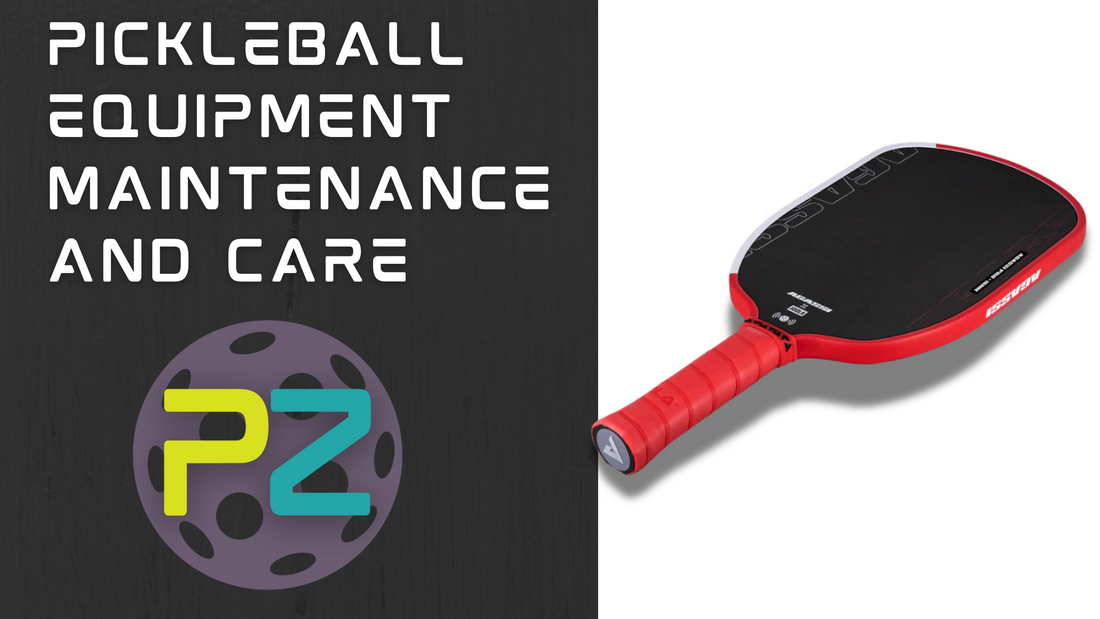
Pickleball Equipment Maintenance and Care
Share
Introduction to Pickleball Equipment
Pickleball is more than just a fun activity—it’s a sport that requires the right equipment to perform at your best. Whether you're using composite or graphite paddles, indoor or outdoor balls, or specific footwear, your gear plays a pivotal role. If you've invested in quality equipment, it makes sense to take care of it. In this guide, we explore essential pickleball equipment maintenance tips that will help preserve your gear and elevate your playing experience.
Why Maintenance Matters for Performance and Safety

It’s easy to overlook how much of a difference clean, well-maintained gear makes. Dirty paddles lose grip. Worn shoes lead to injuries. Cracked balls affect game accuracy. More than just aesthetics, proper upkeep of your pickleball equipment helps avoid mishits, injuries, and early replacement. For consistent performance and a longer equipment lifespan, incorporating routine maintenance is key.
How to Clean Pickleball Paddles
One of the most common questions from players is how to clean pickleball paddles without damaging the surface or grip. The answer is simple: use a microfiber cloth dampened with water or a light soap solution. Avoid harsh cleaners, as they can degrade the paddle’s texture and core. After cleaning, dry the paddle thoroughly and store it in a paddle cover. For sweaty grips, consider replacing them every few weeks—especially if you play frequently.
Proper Storage for Different Types of Pickleball Gear
Where you store your gear matters. Paddles should be kept in a dry, temperate space to avoid core warping or edge delamination. Balls should be stored in a cool place to maintain bounce. Shoes? Let them air out to prevent mold or odor buildup. Pickleball bags with compartments are ideal for organizing gear while keeping it ventilated. If you’re serious about gear longevity, invest in weather-resistant storage for outdoor conditions.

Seasonal Care and Long-Term Storage
When not playing regularly—such as in the off-season—clean and dry all your equipment before storing. For longer breaks, loosen laces in your shoes, wrap paddles in protective cloth, and keep everything elevated off damp floors. Consider using silica gel packets in your bags to keep moisture away. These small steps can add months, even years, to your gear's usability.
Do’s and Don’ts of Equipment Handling
Do: Wipe down gear after every session, rotate paddles, store items safely, inspect gear before play.
Don’t: Leave paddles in hot cars, ignore worn grips, wash shoes in machines, or use abrasive cleaners.
Small bad habits lead to big gear problems.
Signs of Wear and When to Replace Equipment
If your paddle starts sounding dull or loses its pop, it may be time for a replacement. Cracked edges, soft spots, or noticeable loss of spin control are clear signs. Shoes with worn tread or compressed cushioning can cause foot pain or injuries. Balls with visible dents or flat bounce also need replacing. Routine checks help you stay ahead of potential issues.
Common Mistakes in Pickleball Equipment Maintenance
Leaving paddles in extreme weather, never cleaning grips, and overpacking gear into tight bags are just a few errors players make. Over time, these habits wear down even the best equipment. By avoiding these mistakes, you’ll extend the life of your gear significantly.
Choosing Cleaning Products: What Works Best?
Mild soap, microfiber cloths, paddle-safe grip cleaners, and deodorizing sprays for shoes are all effective. Avoid bleach or ammonia-based cleaners as they can damage materials. Products like paddle erasers or grip powders also work well without leaving residue.
Gear-Specific Care: Paddles, Balls, Bags and Shoes
Each item in your arsenal requires specific care. Paddles need surface checks. Balls require bounce tests. Shoes need sole inspections. Bags should be cleaned and checked for mildew, especially if used outdoors. Treat each piece as a performance tool.
What the Pros Do: Maintenance Routines Shared

Pro players often clean gear after every match, rotate multiple paddles, and use high-end breathable bags. They prioritize preparation because they know gear quality influences performance. Copying their routines can help even recreational players.
Eco-Friendly Ways to Clean and Maintain Equipment
Use vinegar-water solutions, biodegradable wipes, or reusable cloths. Recycle old balls and donate used gear when possible. Supporting eco-conscious practices ensures your passion for pickleball doesn’t come at a cost to the planet.
How to Extend the Life of Your Pickleball Paddle
Keep it dry, store it well, clean it regularly, and regrip it as needed. Use edge guard tape to protect the frame and avoid paddle contact with hard surfaces. These practices alone can double your paddle’s lifespan.
Linking Performance to Equipment Condition
When your equipment is well-maintained, you play with more confidence, control, and safety. Not maintaining your equipment can lead to avoidable mistakes and frustration. Gear performance directly affects player performance.
Conclusion: Keep Your Gear Game-Ready
Great players respect their gear—and that starts with care. Follow these pickleball equipment maintenance tips and you’ll not only extend your equipment’s life but also elevate your entire game experience.
For more helpful insights, check out related blogs like:
Pickleball Paddles for Beginners
https://pickleballzonesa.co.za/blogs/news/how-to-choose-the-best-pickleball-paddle-for-beginners
Your Guide to Pickleball Equipment South Africa
https://pickleballzonesa.co.za/blogs/news/your-guide-to-pickleball-equipment-south-africa
And for general gear maintenance, here’s a helpful external resource:
REI Gear Care Guide
https://www.rei.com/learn/expert-advice/care-cleaning.html
